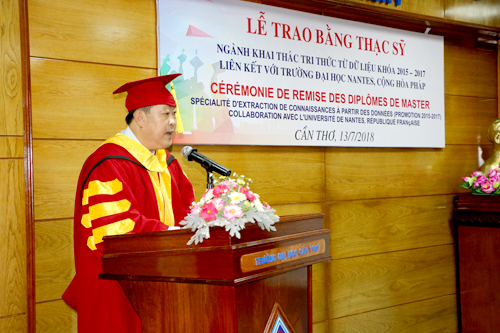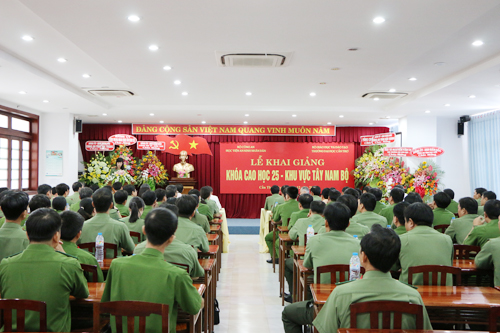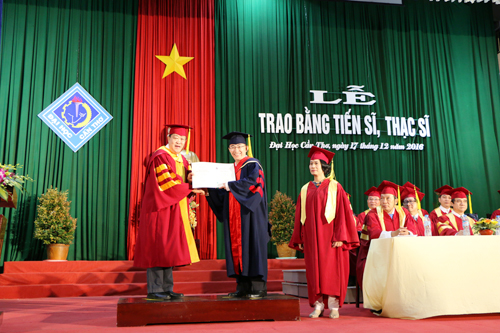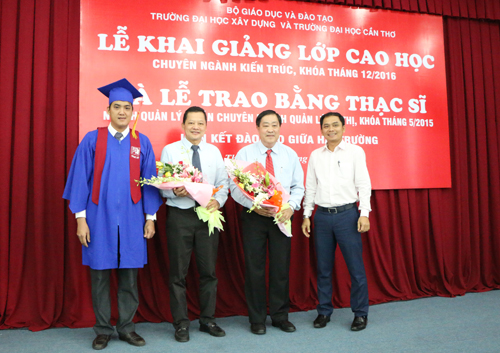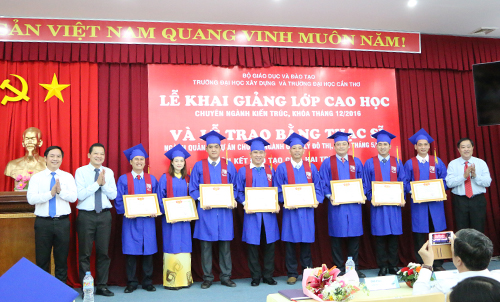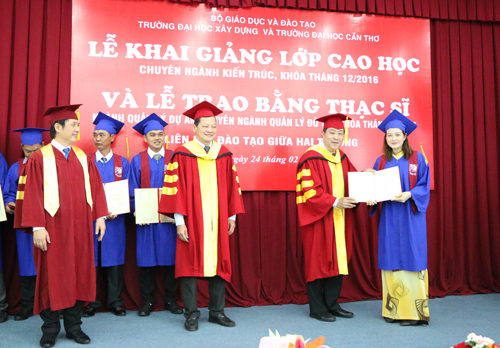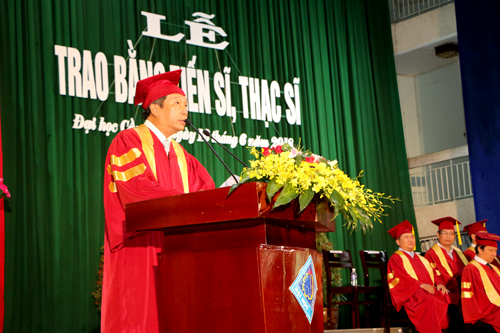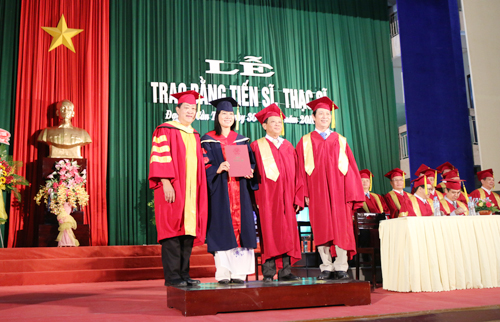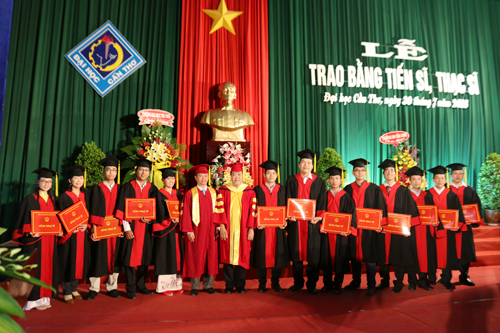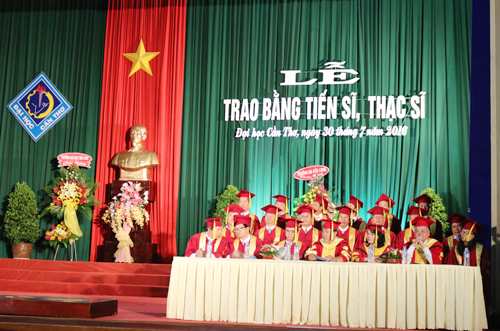
Tên đề tài: “Nghiên cứu đa dạng loài giun đất ở vùng Đông Nam Bộ (Việt Nam) dựa vào dữ liệu hình thái và sinh học phân tử”.
Tác giả: Nguyễn Quốc Nam, Khóa: 2016
Chuyên ngành: Công nghệ sinh học; Mã số: 62420201. Nhóm ngành: Khoa học sự sống
Người hướng dẫn chính: PGS.TS. Nguyễn Thanh Tùng - Trường Đại học Cần Thơ
Người hướng dẫn phụ: TS. Nguyễn Đức Anh - Viện Hàn lâm KH và CN Việt Nam
- Tóm tắt nội dung luận án
Luận án “Nghiên cứu đa dạng loài giun đất ở vùng Đông Nam Bộ (Việt Nam) dựa vào dữ liệu hình thái và sinh học phân tử” bao gồm 04 nội dung:
Nội dung 1, đánh giá độ đa dạng loài giun đất ở Đông Nam Bộ. Tiến hành thu thập các dẫn liệu thư mục và mẫu vật ngoài thực địa, định loại mẫu vật bằng hình thái và sinh học phân tử, tổng kết cấu trúc thành phần loài, xây dựng khóa định loại và lập danh lục các loài giun đất trong họ Megascolecidae hiện diện ở Đông Nam Bộ. Nghiên cứu ghi nhận 44 loài giun đất thuộc 12 giống, 6 họ hiện diện ở khu hệ giun đất Đông Nam Bộ; trong đó, bổ sung 26 loài giun đất mới cho khu hệ bao gồm 15 loài công bố mới cho khoa học (A. dorsomorrioides, A. minhdam, A. longiprostaticus, A. ocularius, M. malayanoides, M. haui, M. setosa, M. grandiverticulata, M. bariaensis, M. iranomala, M. houlletoides, M. planatoides, M. songbeensis, M. xuanlocensis và Ph. vungtauensis). Họ Megascolecidae chiếm ưu thế (37 loài), kế đến là Moniligastridae và Octochaetidae (có 2 loài/họ), các họ còn lại (Almidae, Rhinodrilidae và Ocnerodrilidae) có 1 loài/họ. Trong nhóm Pheretima, giống Metaphire chiếm ưu thế (21 loài), kế đến là Amynthas (8 loài), Polypheretima (4 loài) và Pheretima (1 loài).
Nội dung 2, xác định mối quan hệ phát sinh của các loài giun đất thuộc họ Megascolecidae ở Đông Nam Bộ. Tiến hành giải trình tự đoạn gen COI và 16S rRNA của ty thể giun đất, đánh giá mức độ tương đồng của trình tự thu được trên ngân hàng gen NCBI, tính khoảng cách di truyền K2P và xây dựng cây quan hệ phát sinh giữa các loài trong họ Megascolecidae. Kết quả ghi nhận có sự khác biệt ở mức độ loài dựa trên dẫn liệu phân tử của 32 loài giun đất trong họ Megascolecidae; giống Amynthas và Metaphire chưa có sự tách biệt rõ ràng; loài M. pacseana không được xếp vào nhóm loài peguana; M. cf. campanulata không phải là tên đồng vật của M. houlleti.
Nội dung 3, xác định đặc điểm phân bố của giun đất ở vùng Đông Nam Bộ. Dựa trên các chỉ số sinh thái tính toán được, tiến hành đánh giá định tính đặc điểm phân bố của giun đất theo địa hình, theo loại đất và theo sinh cảnh ở khu vực nghiên cứu. Kết quả ghi nhận ghi nhận mức độ đa dạng giun đất giảm dần từ vùng đồi núi xuống đồng bằng; từ nhóm đất đỏ vàng, đến đất xám và nhóm đất phù sa; từ sinh cảnh ĐTCLN, đến bãi hoang, rừng và ĐTCNN.
Nội dung 4, đánh giá tiềm năng sử dụng các loài giun đất ở vùng Đông Nam Bộ. Dựa trên tần số xuất hiện, độ phong phú, độ đạm tổng số (đo bằng phương pháp Kjeldahl), hoạt tính kháng oxy hoá (đo bằng 4 phương pháp DPPH, ABTS, phosphomolybdenum và RP) để đánh giá tiềm năng sử dụng các loài giun đất ở khu vực nghiên cứu trong nông nghiệp và y học. Kết quả ghi nhận M. posthuma có hoạt tính kháng oxy hóa tốt và ổn định ở cả 4 phương pháp khảo sát; ghi nhận 6 loài giun đất khảo sát (L. mauritii, M. pacseana, A. polychaetiferus, M. posthuma, M. bahli và M. easupana) có độ đạm tổng số cao.
- Những kết quả mới của luận án
Luận án là công trình nghiên cứu đầu tiên về giun đất mang tính hệ thống ở vùng Đông Nam Bộ Việt Nam, đặc biệt là có sử dụng các dữ liệu sinh học phân tử (100 trình tự COI và 76 trình tự 16S rRNA) hỗ trợ trong phân loại học giun đất: nghiên cứu về đa dạng các loài giun đất, công bố các loài giun đất mới cho khoa học, xác định lại vị trí phân loại học của một số loài nghi vấn (M. iranomala, M. cf. campanulata, M. pacseana), mối quan hệ phát sinh chưa rõ ràng giữa hai giống Amynthas và Metaphire. Nghiên cứu này góp phần hoàn chỉnh cơ sở dữ liệu để xây dựng động vật chí cho nhóm loài giun đất ở Việt Nam; xây dựng bộ cơ sở dữ liệu sinh học phân tử về giun đất ở Việt Nam và hướng đến xây dựng lại hệ thống phân loại mới cho nhóm loài Pheretima.
Ngoài ra, luận án còn cung cấp thêm các thông tin về đặc điểm phân bố của giun đất theo các dạng địa hình, sinh cảnh và loại đất ở Đông Nam Bộ; đánh giá hoạt tính kháng oxi hoá và khảo sát độ đạm tổng số của một số loài giun đất phổ biến ở khu vực nghiên cứu.
- Các ứng dụng/khả năng ứng dụng trong thực tiễn, các vấn đề cần tiếp tục nghiên cứu
- Khả năng ứng dụng trong thực tiễn:
Các nội dung nghiên cứu trên góp phần làm cơ sở cho các nghiên cứu ứng dụng của giun đất về sau trong nhiều lĩnh vực như dược học, chăn nuôi và môi trường.
- Các vấn đề cần tiếp tục nghiên cứu:
Cần tiếp tục nghiên cứu trình tự các gen di truyền trong nhân tế bào để bổ sung và làm sáng tỏ các vấn đề còn nghi vấn trong quan hệ di truyền phát sinh của họ Megascolecidae.
Tiếp tục đẩy mạnh các nghiên cứu ứng dụng của giun đất để có thể khai thác nguồn tài nguyên sinh vật này có hiệu quả trong thực tiễn đời sống xã hội.
Dissertation entitled: Research on the species diversity of earthworms in the Southeastern part of Vietnam using morphological and molecular data
Specialization: Biotechnology Code: 62420201
PhD student: Nguyen Quoc Nam
Scientific supervisor: Assoc. Prof. Dr. Nguyen Thanh Tung and Dr. Nguyen Duc Anh
Academic institute: Biotechnology Research and Development Institute, CanTho University
- Thesis summary
The thesis “Research on the species diversity of earthworms in the Southeastern part of Vietnam using morphological and molecular data” includes 4 contents:
The first content, evaluation of the diversity of earthworm species in the Southeast Vietnam. Collecting the bibliographic data and the fields pecimens, classifying the specimens by morphological and molecular data, summarizing the structure of species composition, building the identification keys and cataloging the earthworm species in the family Megascolecidae being present in the Southeast. This study discovered that there were 44 earthworm species belonging to 12 genera and 6 families were recorded in the Southeastern Vietnam; of which, 26 were recorded for the first time in this region including 15 new species (A. dorsomorrioides, A. minhdam, A. longiprostaticus, A. ocularius, M. malayanoides, M. haui, M. setosa, M. grandiverticulata, M. bariaensis, M. iranomala, M. houlletoides, M. planatoides, M. songbeensis, M. xuanlocensis and Ph. vungtauensis). The family Megascolecidae was dominant with 37 species, followed by Moniligastridae and Octochaetidae (each with 2 species), the other families (Almidae, Rhinodrilidae and Ocnerodrilidae) have only 1 species each. In the Pheretimoid group, the genus Metaphire was dominant with 21 species, followed by Amynthas (8 species), Polypheretima (4 species) and Pheretima (1 species).
The second content, determining the phylogenetic relationships of earthworm species of the family Megascolecidae in the Southeast. Sequenced the COI and 16S rRNA gene fragments of earthworm mitochondria, evaluated the similarity of the sequences obtained on the NCBI gene bank, calculated the K2P genetic distance and built a phylogenetic tree between the species in the family Megascolecidae. Recorded results of the specific differences were analyzed based on fragments of COI and 16S rRNA genes of 32 species in the family Megascolecidae; Two genera Amynthas and Metaphire was not clearly separated, the species M. pacseana was not assigned into the M peguana group, and M. cf. campanulata cannot be a synonym of M. houlleti.
The third content, determining the distribution characteristics of earthworms in the Southeast Vietnam. Based on the calculated ecological indicators, conduct a qualitative assessment of the distribution characteristics of earthworms by topography, by soil type and by habitat in the study area. The obtained result is that the earthworm diversity was recorded to decrease gradually from hills to plains; from red and yellow soils to gray soils and alluvial soils; from long-term tree plantations to wastelands, forests and short-term tree plantations.
The fourth content, evaluation of the potential use of earthworm species in the Southeast Vietnam. Based on the occurrence frequency, abundance, total protein (measured by Kjeldahl method), the antioxidant activity (measured by 4 methods DPPH, ABTS, phosphomolybdenum and RP) to evaluate the potential use of earthworm species in the study area about agriculture and medicine. The result showed that M. posthuma has good and stable antioxidant activity in all 4 testing methods; 6 species (L. mauritii, M. pacseana, A. polychaetiferus, M. posthuma, M. bahli and M. easupana) were recorded with high total protein content.
- Novel Achievement
The thesis is the first systematic research on the earthworms in the Southeast Vietnam, especially using molecular data (100 COI sequences and 76 16S rRNA sequences) to support in the earthworm taxonomy: research on the earthworm diversity, publication of new earthworm species for science, redefine the taxonomic positions of some questionable species (M. iranomala, M. cf. campanulata, M. pacseana), be unclear on the phylogenetic relationship between the two genera Amynthas and Metaphire. This achievement contributes to complete the database for building lice for earthworm species in Vietnam; build a molecular data on earthworms in Vietnam and advance to rebuild a new taxonomy for the Pheretima species group.
In addition, the thesis also provides more information about the distribution characteristics of earthworms thanks to the topography, habitats and soil types in the Southeast; Evaluate the antioxidant activity and survey the total protein of some common earthworm species on the research.
- Practical applications and further research
- Practical applications:
The above research contents contribute to the basis for later applied researches of the earthworms in many fields such as pharmacology, animal husbandry and environment.
- Further research:
Further study in the sequence of genes is needed to supplement and clarify the questionable issues in the phylogenetic relationship of the family Megascolecidae.
Continue to promote research on the applications of earthworms to be able to exploit effectively this biological resource in the really social life.
- Xem chi tiết nội dung luận án
- Xem thông tin đăng tải tại Website Bộ giáo dục và Đào tạo. (Nhập tên NCS vào ô tìm kiếm)





